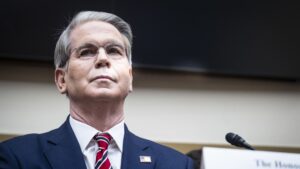Understanding the Impact of Moody’s Credit Rating Downgrade: Insights from Treasury Secretary Scott Bessent
In a notable recent interview on NBC News’ Meet the Press, Treasury Secretary Scott Bessent addressed the critical downgrade of the U.S. credit rating by Moody’s Ratings, which fell from the highest tier of Aaa to Aa1. This marks a significant moment in U.S. financial history, and Bessent didn’t shy away from sharing his candid views.
What Does It Mean to Be a “Lagging Indicator”?
Bessent described Moody’s as a “lagging indicator,” suggesting that the agency tends to reflect past economic realities rather than provide anticipatory insights. “I think that’s what everyone thinks of credit agencies,” he remarked, emphasizing a growing sentiment that credit ratings often trail real economic changes rather than predict them.
Moody’s cited the persistent accumulation of U.S. government debt—currently at a staggering $36.22 trillion—as a primary reason for the downgrade. The agency pointed to rising debt and interest payment ratios that surpass those of similarly rated sovereign nations.
The Political Landscape of Economic Policy
Bessent attributed the downgrade largely to the Biden administration’s spending strategies, framed as investments in pivotal areas such as climate change and healthcare. He argued, “It’s the spending we have seen over the past four years” that laid the groundwork for this downgrade—underscoring that economic challenges are often rooted in long-term policies rather than short-term actions.
This perspective is especially relevant for investors. Understanding the link between governmental financial decisions and credit ratings can provide clues into future market movements and opportunities.
Retail Economics and Tariff Controversies
In addition to discussing credit ratings, Bessent shared insights from his conversation with Walmart CEO Doug McMillon. According to Bessent, McMillon indicated that the retail giant would absorb some of the tariffs, as they did in previous years. This resilience in maintaining lower prices for consumers is vital in today’s economic set-up often influenced by fluctuating tariffs.
Walmart’s CFO previously voiced concerns over rising prices due to tariffs, illustrating the balancing act between corporate profitability and customer affordability. The dichotomy between maintaining low prices and navigating tariffs is an urgent reality for retailers—something investors should keep a sharp eye on as they assess retail stocks.
The Bigger Picture: Economic Negotiations and Geopolitical Relations
Bessent’s remarks extended into the geopolitical arena, touching on ongoing negotiations about tariffs and investment commitments from nations like Qatar and Saudi Arabia. He warned that countries unwilling to negotiate could face harsh duties—a significant factor in understanding U.S. foreign relations and trade policies, especially in an investors’ context.
With ongoing discussions about trade agreements, staying informed on these negotiations is critical for those looking to invest in multinational sectors.
A Critical Perspective from Congress
Not everyone agrees with Bessent’s analysis. Senator Chris Murphy expressed concern, stating the credit downgrade could forecast a potential recession, higher interest rates, and economic strain on businesses and homeowners. His comments shed light on the diverse perspectives surrounding government policies and their potential impact on everyday American lives.
Conclusion: The Future of U.S. Credit and Investment Strategies
As the U.S. navigates this precarious financial landscape, the downgrade by Moody’s serves as a stark reminder of the complex interplay between government policy and economic stability. Whether you’re an investor or simply a concerned citizen, understanding these dynamics is essential for making informed decisions.
At Extreme Investor Network, we emphasize the importance of staying ahead in a changing financial environment. By keeping a pulse on these trends and insights, investors can better navigate the complexities of today’s market and make strategic choices that enhance their financial future. Stay tuned for more insights as we continue to monitor these critical developments.

